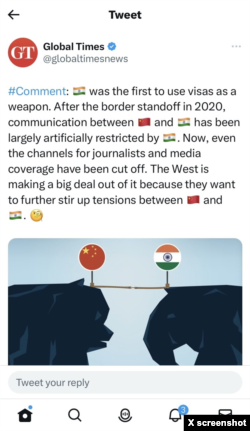On May 30, The Wall Street Journal reported that India and China have rejected visas for almost all of each other’s journalists, wiping out mutual media access between the two Asian colossuses.
At a May 31 press conference, Chinese Foreign Ministry spokesperson Mao Ning said that China had denied or revoked entry visas for Indian journalists in retaliation for the “unfair and discriminatory treatment” that Chinese journalists “have suffered in India for a long time.”
Also on May 31, China’s state media Global Times newspaper weighed in on the issue in a tweet that has since been deleted:
“India was the first to use visas as a weapon…now, even the channels for journalists and media coverage have been cut off. The West is making a big deal out of it because they want to further stir up tensions between China and India.”
That is misleading.
China was the first to relaunch the “visa war.” The two Asian nations, however, are equally at fault for using visa restrictions to limit the presence of each other’s media.
India and China have been engaged in a tit-for-tat spat over journalist visas since bilateral relations deteriorated sharply after a deadly June 2020 border dispute left at least 20 Indian and four Chinese soldiers dead. A second such border incident took place in January 2021, leaving troops from both sides injured.
Since then, both nations have used visa restrictions to hinder access to each other’s media. China claimed India had shortened the validity of visas held by Chinese journalists without providing a legitimate reason. India accused China of making it difficult for Indian journalists working in China to hire locals as correspondents.
This round of tensions started on April 4, 2023, when Chinese authorities told two China-based Indian journalists who had traveled home not to return to China.
The Committee to Protect Journalists, a media rights watchdog, identified the two Indian journalists as Ananth Krishnan, a Beijing-based correspondent for the English-language newspaper The Hindu, and Anshuman Mishra, Beijing-based representative of Indian state broadcaster Prasar Bharati.
China’s Foreign Ministry spokesperson Mao Ning said at the time the move was an appropriate response to “India’s unfair and discriminatory treatment of Chinese journalists.”
However, Reuters noted that Beijing’s action came just days after India objected to China changing the names of 11 locations in the eastern Indian state of Arunchal Pradesh. China calls the area southern Tibet and claims it as its territory.
Fast forwarding to May, the Indian government rejected visa renewals for the last two Chinese state media journalists in the country. One works for Xinhua News Agency and the other works for China Central Television.
Meanwhile, India had four journalists based in China at the beginning of this year, but at least two haven’t been issued visas to return to Beijing. A third was told his accreditation had been revoked, but he’s still in China.
The Hindu’s Ananth Krishnan tweeted on May 31: “We’re down to only one accredited Indian reporter in Beijing — and unfortunately, probably zero soon.”
Neither India nor China is a staunch defender of press freedom within their own borders. In the Reporters Without Borders’ 2023 World Press Freedom Index, India ranked 161st out of 180 countries and regions, while China ranked 179th.
This is not the first time China has used visa restrictions against foreign press for political ends.
In August 2019, China refused to renew journalist credentials for Chuan Han Wong, a Wall Street Journal reporter who had written a story about the activities of one of President Xi Jinping’s cousins in Australia.
In February 2020, China expelled three of its reporters after the newspaper ran an opinion piece headlined “China Is The Real Sick Man of Asia”.
According to the Foreign Correspondents’ Club of China, in the first half of 2020, China expelled at least 18 foreign journalists working for The Washington Post, The New York Times and The Wall Street Journal.
Those expulsions followed Washington’s move capping the number of journalists with state-controlled Chinese media organizations working in the U.S. at 100, from 160 previously.






